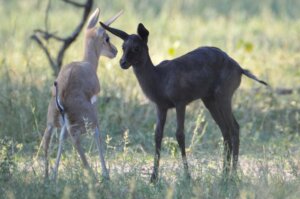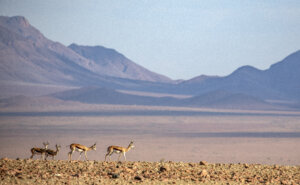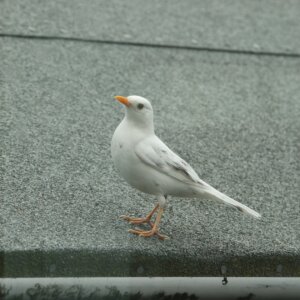Melanism and Thamo Telele’s Black Springbok
 Pru Allison
Pru Allison
 May 01, 2023
May 01, 2023
Life’s always exciting at Thamo Telele thanks to the horseback safaris and the resident herd of giraffe, but thunder’s being stolen from the usual stars of the show by a rather unusual little springbok lamb.
You’re almost certainly familiar with the springbok, it is after all the most distinctive of Southern Africa’s antelopes thanks to the flash of deep brown that separates the tan from the white along its elegant body.
Thamo Telele’s lamb looks rather different though, because it’s virtually black.

The black springbok lamb at Thamo Telele
While it’s still too early to decipher the baby’s gender one thing’s for certain – this is one of the most unusual springboks we’ve ever seen.
“It is melanistic,” explains Thamo Telele’s giraffe scientist Emma Wells. “We believe it to be a highly recessive gene combination. This one has the black stripe like ‘normal’ springbok and the rest of it is a dark charcoal colour.”
The word melanism comes from the Greek ‘melanos’, meaning dark coloured, and it is what we see when an animal has an increased amount of dark pigmentation. Melanistic animals develop too much melanin in the skin. In most cases it’s believed to be the result of a recessive gene.
“In jaguars it’s the dominant gene,” notes private guide Peter Allison. “Melanism has been seen in many species including honey badgers, servals, leopards and in this case a springbok. In Malaysia all the leopards are black because the melanistic gene has become prevalent in a small area and it’s likely the animals there are closely related.”
What we see in Malaysia is actually a phenomenon known as adaptive melanism which is where the melanistic animals have an advantage through camouflage or sun protection and become more likely to survive and reproduce than those with normal colours. Their offspring are more likely to be melanistic and over time an entire population might become melanistic.

Standard springbok colouration (Kwessi Dunes)
In the case of Thamo Telele it’s believed that a previous owner kept black springbok and although the last one died several years ago, this would make the recessive genes more prevalent in the population. Melanism isn’t always an advantage though, often the opposite is true.
“The disadvantage for a melanistic prey animal is that it stands out and predators are often looking for something that stands out,” adds Peter Allison.
Similar but not quite the same is pseudo-melanism or abundism that also sees an increase of melanin and results in more prominent markings than would usually occur such as bigger and darker stripes or spots. An example of this is the king cheetah.
At the opposite end of the colour scale are albinism and leucism in which animals appear to be far paler than usual. Albinism affects the production of melanin in an animal’s cells, making them completely white right down to lighter eye colours (usually pink), while leicism is when partial loss of all types of pigmentation occurs resulting in an uneven lightening effect.

Leicism in a blackbird.
Melanism can occur in mammals, reptiles and insects, but is seen less frequently than albinism or leicism. The exception to this is birds in whom it’s actually the most common colour morph. This darkened colouration has even seen melanistic birds declared as new species before science has a deeper understanding of this colour quirk (Hein van Grouw, 2017; The Dark Side Of Brids; bioone.org).
A springbok might not seem that exciting a sighting, but in the case of this little lamb it’ll definitely be the envy of other travellers along your journey.
Special Offers
Our special offers are designed to help you experience everything southern Africa has to offer whilst also saving some all-important pennies. Whether you’re about to embark on a once-in-a-lifetime solo trip, or are celebrating a special occasion, have a peek at our offers and see what could be in store for you.
























